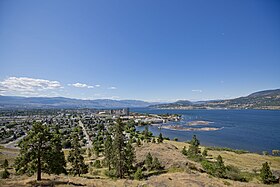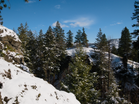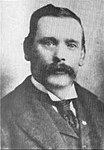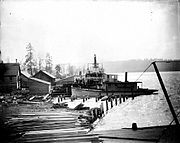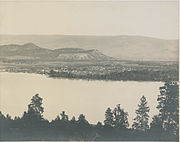
A | B | C | D | E | F | G | H | CH | I | J | K | L | M | N | O | P | Q | R | S | T | U | V | W | X | Y | Z | 0 | 1 | 2 | 3 | 4 | 5 | 6 | 7 | 8 | 9
Kelowna | |
|---|---|
| City of Kelowna | |
|
From top, left to right: Downtown Kelowna from Knox Mountain Park, the peaks of Central Okanagan, Mission Hill Winery and Bell Tower, the William R. Bennett Bridge on Okanagan Lake, Okanagan Lake near Rotary Beach Park | |
| Nickname(s): | |
| Motto: "Fruitful in Unity" | |
| Coordinates: 49°53′17″N 119°29′44″W / 49.88806°N 119.49556°W[3] | |
| Country | Canada |
| Province | British Columbia |
| Regional district | Central Okanagan |
| Settled | 1879 |
| Incorporated | May 5, 1905 |
| Government | |
| • Type | Elected city council |
| • Body | Kelowna City Council |
| • Mayor | Tom Dyas |
| • MP | Dan Albas (CPC) Tracy Gray (CPC) |
| • MLAs | Norm Letnick (BCU) Renee Merrifield (BCU) Ben Stewart (BCU) |
| Area | |
| • City | 211.85 km2 (81.80 sq mi) |
| • Metro | 2,904.86 km2 (1,121.57 sq mi) |
| Elevation | 344 m (1,129 ft) |
| Population (2021) | |
| • City | 144,576 |
| • Density | 680/km2 (1,800/sq mi) |
| • Metro | 222,162 |
| • Metro density | 76/km2 (200/sq mi) |
| [5] | |
| Gross Metropolitan Product | |
| • Kelowna CMA | CA$11.3 billion (2020)[6] |
| Time zone | UTC−08:00 (PST) |
| • Summer (DST) | UTC−07:00 (PDT) |
| Forward sortation area | |
| Area code(s) | 250, 778, 236, 672 |
| GNBC Code | JAFUV[7] |
| Website | kelowna |
Kelowna (/kəˈloʊnə/ kə-LOH-nə) is a city on Okanagan Lake in the Okanagan Valley in the southern interior of British Columbia, Canada. It serves as the head office of the Regional District of Central Okanagan. The name Kelowna derives from the Okanagan word kiʔláwnaʔ, referring to a grizzly bear.[8][9]
Kelowna is the province's third-largest metropolitan area (after Vancouver and Victoria), while it is the seventh-largest city overall and the largest in the Interior.[10] It is the 20th-largest metropolitan area in Canada. The city proper encompasses 211.85 km2 (81.80 sq mi),[4] and the census metropolitan area 2,904.86 km2 (1,121.57 sq mi).[4] Kelowna's estimated population in 2020 is 222,748 in the metropolitan area and 142,146 in the city proper.[11] After a period of suburban expansion into the surrounding mountain slopes, the city council adopted a long-term plan intended to increase density instead — particularly in the downtown core. This has resulted in the construction of taller buildings, including One Water Street — a 36-story building that is the tallest in Kelowna.[12] Other highrise developments have already broken ground or been approved since then, including a 42-storey tower on Leon Avenue which will be the tallest building in the city, and among the tallest in B.C.[13]
Nearby communities include the City of West Kelowna (also referred to as Westbank and Westside) to the west, across Okanagan Lake; Lake Country and Vernon to the north; Peachland to the southwest; and Summerland and Penticton to the south.
History
The exact dates of first settlement in the Okanagan Valley are unknown, but a northern migration led to the habitation of this area some 9,000 years ago.[14] The Indigenous Syilx people are the first known inhabitants of the region, where they continue to live today.
In 1811, David Stuart travelled to the Okanagan Valley, becoming the first European to do so.[15] Despite this, it was not until 1859 that Father Pandosy, a French Roman Catholic Oblate missionary, became the first European to settle there. Pandosy's settlement was located at l'Anse au Sable (Bay of Sand), which he named in reference to the sandy shoreline. Although the population remained small for the rest of the 19th century, sustenance fruit growing expanded in Kelowna during the 1870s, and by the 1890s, commercial agriculture had become firmly established.[16]
Kelowna was officially incorporated on May 4, 1905, with a population of 600.[17] The town's first mayor was Henry Raymer.[15]
Although agriculture had become an important mark of Kelowna on the surrounding region, the town was entirely reliant on transportation over Okanagan Lake until 1925. In 1893 the Canadian Pacific Railway (CP) constructed the steamer SS Aberdeen on the lake, which served as the first significant transportation link between Kelowna and Penticton, greatly increasing the speed of Kelowna's growth.[18] On September 11, 1925, CP was extended to Kelowna, ending the town's reliance on Okanagan Lake for transportation and trade.[15]
In 1911, Chinese revolutionary Sun Yat-sen visited Kelowna for fundraising. At that time, approximately 15 per cent of the population was ethnically Chinese.[19]
On August 6, 1969, a sonic boom from a nearby air show broke a quarter million dollars worth of glass, injuring six people. The destruction was caused by a member of the United States' Blue Angels during a practice routine for the Kelowna Regatta festival when the pilot accidentally broke the sound barrier while flying too low.[20]
On November 25, 2005, the First Ministers and National Aboriginal Leaders signed the Kelowna Accord, which sought to improve the lives of Indigenous peoples.[21]
Kelowna celebrated its centennial in May 2005. The same year, construction began on the five-lane William R. Bennett Bridge to replace the three-lane Okanagan Lake Bridge, as part of a plan to alleviate traffic problems during summer tourist season. The new bridge was completed in 2008.[22]
On July 12, 2021, a crane suffered a catastrophic failure while being dismantled at a construction site located at St. Paul Street near Bernard Avenue in downtown Kelowna. Part of the crane struck a nearby office building and seniors home. The city declared a local state of emergency and area residents were evacuated. Five people were killed in the collapse: four construction workers and one person in the office building.[23][24]
-
Henry Raymer, the first mayor of Kelowna
-
The SS Aberdeen (back) and a smaller steamship (the Kelowna, front) in dock at Kelowna in 1906
-
Kelowna in 1909 as viewed from across Okanagan Lake
-
The center of Kelowna during the 1920s
Wildfires
In Kelowna many seasonal wildfires have occurred over the years. Some significant fires warranting evacuations and/or causing damage are listed below:
- In August 2003, a nearby wildfire destroyed 239 homes and forced the temporary evacuation of about 30,000 residents.[25] Many trestles of the historic Kettle Valley Railway were destroyed. The trestles have been rebuilt to look like the originals, but using smaller dimension beams. This fire consumed 25,000 hectares of land.
- In July 2009, wildfires destroyed hundreds of hectares of forest and a number of buildings in West Kelowna; 17,000 residents were evacuated.[26]
- In July 2009, a 100-ha fire near Rose Valley caused the evacuation of 7,000 people. No structures were lost.
- In July 2009, a 9,200-ha fire behind Fintry caused the evacuation of 2,500 people. No structures were lost.
- In September 2012, a late-season, 200-ha fire destroyed seven buildings and caused the evacuation of 1,500 people in the community of Peachland.
- In July 2014, a 340-ha fire behind the West Kelowna subdivision of Smith Creek caused the evacuation of 3,000 people.
- In July 2015, a 560-ha fire near Shelter Cove caused the evacuation of 70 properties.
- In August 2015, a 130-ha fire burned near Little White Mountain, just south of Kelowna.
- In August 2017, a 400-ha fire in the Joe Rich area caused the evacuation of over 474 properties.[27]
- In August 2023, a 6,800 hectares (17,000 acres) fire was burning in the McDougall Creek area on the west side of Okanagan Lake, causing the evacuation order of over 2,400 properties; winds carried embers across the lake to Kelowna, spawning fires and the loss of city structures.[28]
Geography
Landmarks
- Mission Creek
- Bellevue Canyon
- Layer Cake Hill
- Pinnacle Rock
- Gallagher's Canyon
- Crawford Falls
- Knox Mountain
- Myra Canyon
- Mission Creek Falls
- Black Knight Mountain
- Maude-Roxby Wetlands
- Okanagan Lake
Vegetation

Kelowna's official flower is Balsamorhiza sagittata, commonly referred to as arrowleaf balsamroot.[29]
Climate

Kelowna is classified as a humid continental climate or an inland oceanic climate per the Köppen climate classification system due to its coldest month having an average temperature slightly above −3.0 °C (26.6 °F) and below 0 °C (32 °F),[30] with dry, hot, sunny summers and cool, cloudy winters, and four seasons.[31][32] The official climate station for Kelowna is at the Kelowna International Airport, which is at a higher elevation than the city core, with slightly higher precipitation and cooler nighttime temperatures. Kelowna has the second mildest winter of any non-coastal city in Canada, after neighbouring Penticton.[33] This is caused by the moderating effects of Okanagan Lake combined with mountains separating most of BC from the prairies; however Arctic air masses do occasionally penetrate the valley during winter, usually for very short periods. The coldest recorded temperature in the city was −36.1 °C (−33.0 °F) recorded on 30 December 1968.
Weather conditions during December and January are one of the cloudiest in Canada outside of Newfoundland due to persistent valley cloud. As Okanagan Lake hardly ever freezes, warmer air rising from the lake climbs above colder atmospheric air, creating a temperature inversion which can cause the valley to be socked in by cloud. The last time the lake completely froze over was in the winter of 1969. It may have frozen over in the winter of 1986.[34] This valley cloud has a low ceiling, however, and often bright sunshine can be experienced by driving only 20 minutes or so up into the nearby mountains, above the cloud. Summers in Kelowna are very warm (sometimes hot) and sunny, with daytime temperatures often exceeding 32 °C (90 °F). Not unusually, heat waves occur in July, August, and even June and September on occasion, where temperatures above 30 °C (86 °F) persist for weeks. Temperatures usually reach the high 30's °C or above for at least a few days each summer. The hottest temperature ever recorded in Kelowna was 45.7 °C (114.3 °F) on June 29, 2021.[35] During summer, clear, dry air allows night-time temperatures to fall rapidly, however nights are somewhat warm by Canadian standards. The city averages about 380 mm (15 in) of precipitation per year, with about a fifth of the precipitation falling as snow, the bulk in December and January; however, June is the wettest month of the year.
While some smaller communities such as Blue River and Golden get less wind, Kelowna has the greatest percentage of "calm" wind observations for any major city in Canada (39% of the time).[36][37] The four-year average wind measured at the airport has been less than 5 knots (9.3 km/h; 5.8 mph) on average 10 to 12 months of the year between 2008 and 2011.[38] As shown in the climate chart below, Kelowna has an average high temperature that is above freezing every month of the year - an exceptionally rare phenomenon for an inland Canadian city. In fact, average high temperatures in January surpass those of the most southern areas in Canada, such as Windsor, Ontario. Kelowna's average year-round high temperature of about 14.3 °C (57.7 °F) is also one of the highest in Canada - largely due to the rare combination of high summer temperatures typical of continental climates, along with relatively mild winters - a very rare feature of a continental climate.
| Climate data for Kelowna (Kelowna International Airport) WMO ID: 71203; coordinates 49°57′22″N 119°22′40″W / 49.95611°N 119.37778°W; elevation: 429.5 m (1,409 ft); 1981–2010 normals, extremes 1899–present[a] | |||||||||||||
|---|---|---|---|---|---|---|---|---|---|---|---|---|---|
| Month | Jan | Feb | Mar | Apr | May | Jun | Jul | Aug | Sep | Oct | Nov | Dec | Year |
| Record high humidex | 13.0 | 14.5 | 21.1 | 28.0 | 37.0 | 48.0 | 46.4 | 45.6 | 34.9 | 26.7 | 20.6 | 17.8 | 48.0 |
| Record high °C (°F) | 14.8 (58.6) |
17.2 (63.0) |
20.8 (69.4) |
28.1 (82.6) |
34.4 (93.9) |
45.7 (114.3) |
39.7 (103.5) |
39.3 (102.7) |
35.0 (95.0) |
26.8 (80.2) |
20.6 (69.1) |
17.8 (64.0) |
45.7 (114.3) |
| Mean daily maximum °C (°F) | 0.8 (33.4) |
3.6 (38.5) |
10.1 (50.2) |
15.5 (59.9) |
20.2 (68.4) |
24.2 (75.6) |
27.9 (82.2) |
27.6 (81.7) |
21.7 (71.1) |
13.4 (56.1) |
5.6 (42.1) |
0.7 (33.3) |
14.3 (57.7) |
| Daily mean °C (°F)
Zdroj:https://en.wikipedia.org?pojem=Kelowna,_BC Text je dostupný za podmienok Creative Commons Attribution/Share-Alike License 3.0 Unported; prípadne za ďalších podmienok. Podrobnejšie informácie nájdete na stránke Podmienky použitia.
Analytika
Antropológia Aplikované vedy Bibliometria Dejiny vedy Encyklopédie Filozofia vedy Forenzné vedy Humanitné vedy Knižničná veda Kryogenika Kryptológia Kulturológia Literárna veda Medzidisciplinárne oblasti Metódy kvantitatívnej analýzy Metavedy Metodika Text je dostupný za podmienok Creative
Commons Attribution/Share-Alike License 3.0 Unported; prípadne za ďalších
podmienok. www.astronomia.sk | www.biologia.sk | www.botanika.sk | www.dejiny.sk | www.economy.sk | www.elektrotechnika.sk | www.estetika.sk | www.farmakologia.sk | www.filozofia.sk | Fyzika | www.futurologia.sk | www.genetika.sk | www.chemia.sk | www.lingvistika.sk | www.politologia.sk | www.psychologia.sk | www.sexuologia.sk | www.sociologia.sk | www.veda.sk I www.zoologia.sk | |||||||||||||

